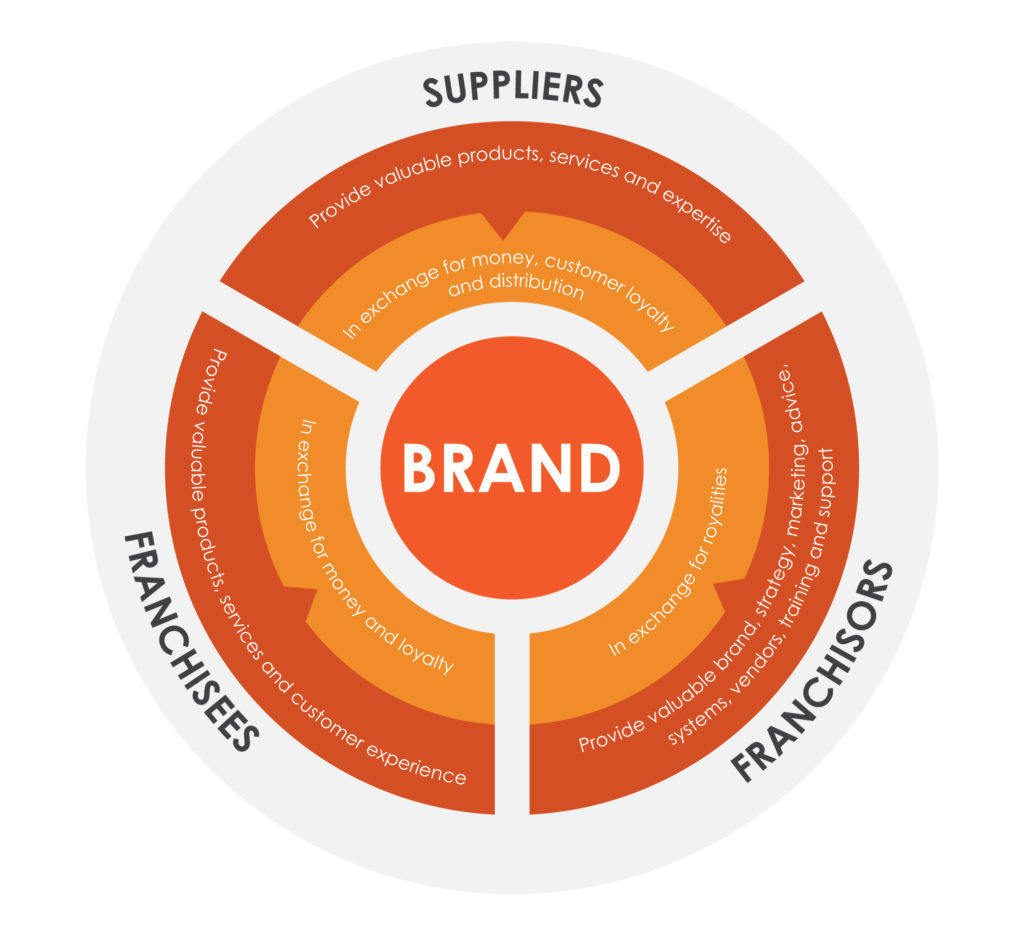
PERFECTING YOUR VALUE CHAIN
Peak-performing national franchise brands relate to franchising different than Early Stage, Emerging, and Turnaround brands. Leadership would assert the franchisor exists for the sole purpose of adding more perceived value to franchisees in the form of business systems, marketing, resources, brand equity, strategic partners, and bottom-line results than it extracts from them in royalties and other franchisor-related costs of doing business.
Additionally, they would contend franchisees exist for the sole purpose of delivering more measurable and perceived value to customers in the form of products, services, and overall customer experience than it charges in price.
As long as the brand’s value chain (depicted below) continually produces high measurable and perceived value for its constituency, the brand thrives, creates momentum, grows, and takes on a life of its own, which we previously depicted in our recent blog about the FPG Franchising Flywheel.

5 WAYS SMART FRANCHISE CANDIDATES DEFINE VALUE
Ultimately, the franchisor’s value proposition as a business opportunity can be chunked down into 5 basic buckets. Franchisors need to bat “5 for 5” in delivering these values or, eventually, the flywheel stops spinning and the brand will experience loss of momentum and become a turnaround situation.
These 5 value drivers are:
1. Uniqueness
How difficult are the products, services, and business model for competitors to copy? Easy-to-copy businesses attract copycats. Where easy-to-copy brands used to be able to fly under the radar screen, make money, and attract little attention until they hit their tipping point, now that we have entered the information age, this is no longer the case. Sectors commoditize faster than any other time in history of franchising. For instance, observe self-serve frozen yogurt. The category started, grew, and collapsed on itself all within less than 10 years.
Almost everyone followed the same green and pink color scheme, bought product from the same dairy, dispensed product from the same machines, and served the same mixings and toppings. Brands commoditized, eventually everyone competed on price, margins were squeezed, driving down profitability to unsustainable levels. Customers had no compelling reason to stay loyal to a singular brand, leaving brands to compete on price or proximity. These businesses started cutting staff, meaning they didn’t have enough people on payroll to keep the toppings bars and bathrooms clean, creating a negative customer experience, eventually killing the category. According to a survey conducted by Statistics Brain in September 2017, there were only 820 yogurt shops remaining in the United States.
Every iconic brand starts with a signature product or service to establish a leadership position and then evolves to add value in other areas. Dan Cathy, CEO of Chick-fil-A, is reportedly fond of saying, “Every business has to have its chicken sandwich.” However, people don’t go to Chick-fil-A just for the chicken sandwich. They offer a unique customer service experience called “polite,” which no other company seems to be able to replicate. Their hiring and training methods for rank-and-file workers are best-in-class. Their target market continues to reward their values with their wallets, elevating Chick-fil-A into the highest-grossing QSR chain in the United States.
Do not confuse “unique” with “first-to-market.” Unique can also mean “difficult to copy.” Chick-fil-A neither invented the chicken sandwich nor polite service. But they have uniquely combined the two to elevate their brand to “Iconic” status.
2. Profitability
What are the unit-level economics? The business model consistently and predictably meets or exceeds what the franchise candidates would say is a reasonable return on their investment of capital, time, and energy.
Many times franchisors get into franchising because their model doesn’t provide a valuable enough return for the chain to scale. They see franchising as a low-risk, low-investment way to scale their business using franchisees’ effort and capital. What they fail to realize is that if the returns don’t meet their criteria to entertain more risk, then the returns are probably not adequate enough to attract high-capacity franchisees either.
When the financial model meets or exceeds franchisees’ expectations, then existing franchisees expand rapidly, which is the lowest-risk and most financially rewarding way franchisors can grow a chain. Why? Existing franchisees are a known entity, eliminating much risk. Because they already have expertise, they are easier to support, leading to higher margins than new franchisees for the same royalty dollars. In addition, franchise candidates know that if existing franchisees are reinvesting, the model is working well.
One time, the founder of a struggling Emerging Growth franchisor told me, “Our franchisees don’t think they are making money simply because their checking account balances are declining. They have to look at all the key performance criteria of the business.” And he was serious. Because he wouldn’t listen to the profitability and ramp-up concerns his franchisees had, this once high-flying chain is starting to plateau and is in danger of losing its flywheel momentum. Since the franchisees’ definition is all that matters, acceptable financial returns are subjective and will vary by the brand, franchisee profile, and category. The franchisor has no say as to whether his franchisees believe they are generating acceptable financial returns.
For owner-operator models, the criteria may initially be “How quickly can I get to my replacement income?” After that criteria is met, they may compare the business strictly against opportunity cost, meaning “Am I making more than I would have made if I kept my job?” They may put little value on business equity appreciation and driving net worth. The franchisees may also assign a monetary value to the intangibles of owning a business such as little-to-no business travel, workday flexibility, and having independence and control.
Conversely, in scalable brick-and-mortar operations such as the QSR segment, the “empire builder” criteria may solely be financial – most notably ROI, EBITDA, and cash-on-cash returns. If the business doesn’t produce an EBITDA of 15% or more, these investor types may believe the model lacks resilience. Because of the lower-than-desired margins, they fear the business can’t absorb increases in product, labor, rent, or other costs without needing to immediately pass those costs to the customer in the form of a price increase. Lastly, a small decrease in sales can threaten profitability, requiring cost-cutting or other tactical measures. That can force the business off its strategic plan and into a “circle-the-wagons” mentality, or even leave it fighting for survival.
3. Defensibility
How will this chain fare against competition? A defensible business has high barriers to entry, making it difficult for competition to gain a new beachhead and threaten the brand’s leadership position. Barriers can be in the form of cost of entry, real estate requirements, expertise, proprietary nature of products, and key customer relationships.
A low barrier to entry business can and will attract new competition, running the risk of creating a commodity environment within the segment. That ultimately leads all chains to largely compete on price. At best, this destroys the model’s profitability and scalability. At worst, it threatens the franchisees’ existence.
For example, Huntington Learning Centers and Sylvan have long been the leaders in remedial education. The strength of their models depended on spreading the high hourly labor expense out over a 3:1 or 4:1 student to teacher ratio. However, tutoring service chains emerged offering one-on-one home-based tutoring. As one-on-one became more of the norm, Huntington and Sylvan’s margins eroded because they had only one child’s revenue to offset the high teacher labor cost. In addition, Sylvan and Huntington were stuck with the high fixed cost of an office or retail location, while the in-home model didn’t have high fixed costs. That isn’t to say these brands can’t still compete, but it is to say their brand position has exposure in the minds of the franchise buyer.
The next wave of tutoring may be delivered virtually, which will eliminate the expense of labor hours burned commuting from one home to another. Lower-cost providers may emerge who pass some or all of these labor savings along to the customers to create a pricing advantage, putting more of a squeeze on the higher-fixed-cost remedial education models.
4. High perceived value
Do customers believe they receive high perceived value from the franchisor’s product or service relative to its cost? We will flesh this point out in detail in our next blog, “How Customers Define Value.”
In addition to delivering high perceived customer value, does the franchisor add more perceived value to the franchisee than it extracts in royalties? For the brand to thrive, it needs to deliver high perceived value to all of its stakeholders and constituents.
5. Long-term sustainability
Will the franchisor predictably create value for its customers and franchisees into the foreseeable future? What is the brand’s plan for staying relevant? How will the brand react to competitive forces, external threats, and buyer trends? What is the likelihood the business will remain profitable over the next 10-20 years?
For instance, Meineke and Midas used to make their money exclusively by marketing automobile exhaust systems. At one time, due to rust and corrosion, automobile owners often needed to be replaced every five years. When automobile manufacturers started making exhaust systems from stainless steel or aluminum, exhaust systems lasted much longer, often the lifetime of the vehicle.
The extended life of these parts disrupted the Midas and Meineke business model, forcing each to enter the general auto repair and maintenance business and go after lines of business the brands were not historically known for.
Keep in mind these brands are already iconic. However, they reinvented their brands based on where the opportunities were. Both were challenged by the fact they had spent millions of dollars in advertising for half a century telling customers “We sell mufflers.” Then they found themselves in the tough position of telling customers, “Forget that. Now we fix brakes and do oil changes.”
The fitness industry is subject to fads and short-lived trends, creating many brand casualties.
For instance, the market has seen quick growth and exits on spin classes, rowing classes, aerobics, pilates, hot yoga, cold yoga, room-temperature yoga, and gender-specific concepts like Curves. Now we have boxing, kickboxing, MMA, barre classes, and a variety of exercise boot camps and other concepts like UFC Gyms.
One self-sabotaging way franchisors threaten their own long-term viability is when they tie their brand to specific trends or products, like Yogurtland. By doing so, they inadvertently link the brand to the typical product life cycle. This means as the product demand declines, the brand becomes irrelevant, creating the strong possibility of a premature brand demise.
If “Yogurtland” was more broadly named “Frozen Dessert Land,” they could have diversified or adjusted the menu while still being brand-consistent.
Cupcake concepts are experiencing the same issues. To survive, they will need to rebrand as bakeries before cupcake sales decline and franchisees have no money to reinvest.
CREATE AN “ADDED VALUE” CULTURE
When the brand establishes a culture and habit of adding more perceived value to its constituents than it charges them in price, the franchise flywheel spins faster creating a situation where the chain produces greater outcomes with less time, money, and capital invested. Any breaks in the value chain left unattended will eventually cost the chain in the form of loss of momentum, leading first to a plateau and then decline, often taking at least three years to recover from. Because the market moves so quickly, those three years of lost opportunity will be disproportionately captured by other market leaders, weakening the brand’s competitive positioning and threatening the livelihood of the franchisees.
MORE ON THE FRANCHISE FLYWHEEL EFFECT
This article is the fourth in a five-part series on the Franchise Flywheel Effect. Read the first three parts here:
- Open Letter to Smart Franchisors: Capitalize on the Current Market Disruption
- The Best Predictors of a Franchisor’s Success
- The Franchise Flywheel Effect
And be on the lookout for part five:
- How Customers Define a Brand’s Value (coming soon)
JOIN THE NEW FRANCHISING THOUGHT LEADERS LINKEDIN GROUP
Join FPG’s moderated LinkedIn Group dedicated to forward-thinking franchisor professionals, franchisees, suppliers, private equity, lenders, and all students of the franchising industry.
Franchising Thought Leaders. No advertising. No personal agendas. Just “must-read” content, thoughtful discussion, case studies, and debate about franchising best practices and the future of franchising.
